What is SDL (from Baidu Encyclopedia):
SDL (Simple Direct Media Layer) is an open source cross-platform multimedia development library written in C language. SDL provides several functions to control the input and output of images, sounds, and so that developers can develop across multiple platforms (Linux, Windows, Mac) with the same or similar code. OS X, etc.) application software. At present, SDL is mostly used to develop games, simulators, media players and other multimedia applications.
This shows that SDL is cross-platform, and Android is based on Linux, so SDL can also be compiled into available dynamic libraries in Android for use. So what role does SDL play on Android? Because I'm an application developer myself, I naturally think of a media player (haha). It can play audio and video with FFmpeg, but this is what I will study later.
One: SDL Download
1) Official Download Address( https://www.libsdl.org/download-2.0.php (SDL2-2.0.5)
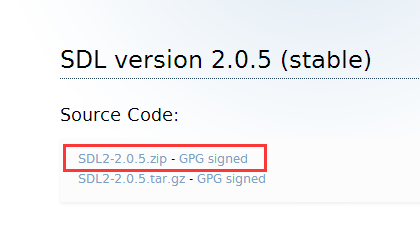
2) To decompress SDL2-2.0.5.zip, we need android-project, include, src and Android.mk
Second: Create SDL Project
1) Create a new pure Android project (package name is the same as in android-project: org.libsdl.app)
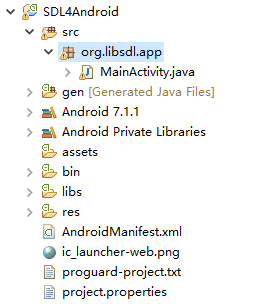
2) Create the jni directory under the root directory of the Android project, then create the SDL directory under the jni directory, and copy the include and src under the SDL2-2.0.5 root directory to the SDL directory:
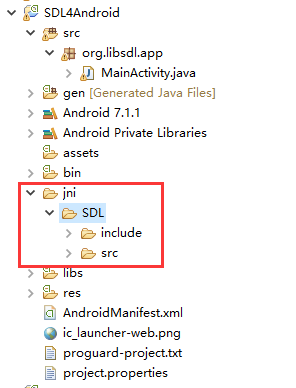
3) Convert Android Projects into C/C++ Projects: Right-click on Android Projects - > Android tools->Add Native support
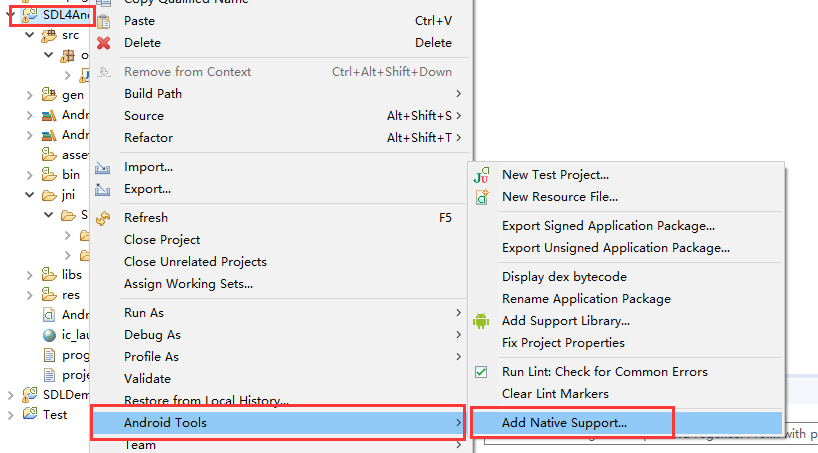
Here's the default name.
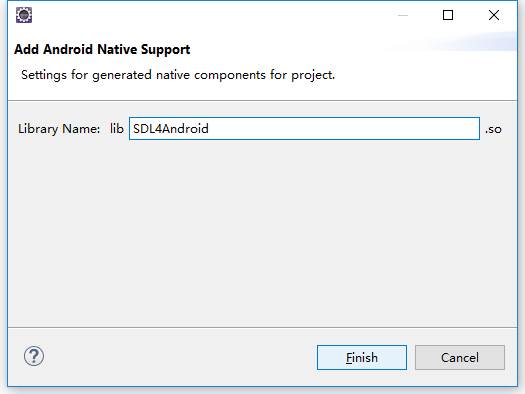
Android.mk and A. cpp file are generated in the jni directory of the converted project. I am used to changing. CPP to. c.
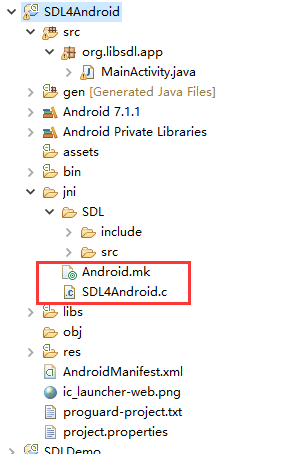
4) Now is the important place.
1. In the SDL directory android-project, we found three files in jni: src, Android.mk and Application.mk:
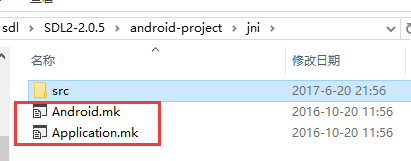
2. In the src directory, there are Android.mk and Android_static.mk files:
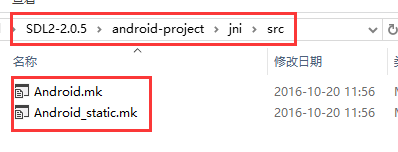
3. This is what the government has done for us. The compilation scripts of mk and two of src are divided into dynamic and static libraries. Here we take Android.mk (shared dynamic library) from src Copy to SDL directory:
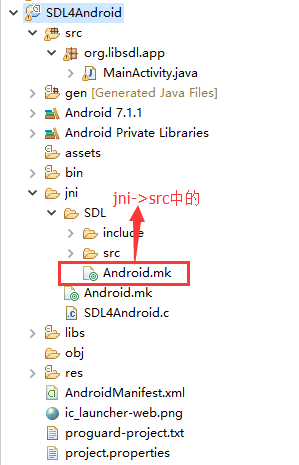
4. Next, we share the Android.mk file in the SDL2-2.0.5 root directory The library code is copied to Android.mk in SDL. Finally, the Android.mk file in SDL is as follows:
5) Now change the content of Android.mk in the JNI directory of the project to include $(call all-subdir-makefiles) which is actually the content of Android.mk in SDL2-2.0.5\ android-project jni. This sentence means calling all MK files in the subdirectory so that the MK files in the SDL directory can be executed. Then copy the Application.mk in SDL2-2.0.5 android-project JNI to the project JNI directory, and finally as shown in the figure:LOCAL_PATH := $(call my-dir) include $(CLEAR_VARS) LOCAL_MODULE := main SDL_PATH := ../SDL LOCAL_C_INCLUDES := $(LOCAL_PATH)/$(SDL_PATH)/include # Add your application source files here... LOCAL_SRC_FILES := $(SDL_PATH)/src/main/android/SDL_android_main.c \ YourSourceHere.c LOCAL_SHARED_LIBRARIES := SDL2 LOCAL_LDLIBS := -lGLESv1_CM -lGLESv2 -llog include $(BUILD_SHARED_LIBRARY) ########################### # # SDL shared library # ########################### include $(CLEAR_VARS) LOCAL_MODULE := SDL2 LOCAL_C_INCLUDES := $(LOCAL_PATH)/include LOCAL_EXPORT_C_INCLUDES := $(LOCAL_C_INCLUDES) LOCAL_SRC_FILES := \ $(subst $(LOCAL_PATH)/,, \ $(wildcard $(LOCAL_PATH)/src/*.c) \ $(wildcard $(LOCAL_PATH)/src/audio/*.c) \ $(wildcard $(LOCAL_PATH)/src/audio/android/*.c) \ $(wildcard $(LOCAL_PATH)/src/audio/dummy/*.c) \ $(LOCAL_PATH)/src/atomic/SDL_atomic.c \ $(LOCAL_PATH)/src/atomic/SDL_spinlock.c.arm \ $(wildcard $(LOCAL_PATH)/src/core/android/*.c) \ $(wildcard $(LOCAL_PATH)/src/cpuinfo/*.c) \ $(wildcard $(LOCAL_PATH)/src/dynapi/*.c) \ $(wildcard $(LOCAL_PATH)/src/events/*.c) \ $(wildcard $(LOCAL_PATH)/src/file/*.c) \ $(wildcard $(LOCAL_PATH)/src/haptic/*.c) \ $(wildcard $(LOCAL_PATH)/src/haptic/dummy/*.c) \ $(wildcard $(LOCAL_PATH)/src/joystick/*.c) \ $(wildcard $(LOCAL_PATH)/src/joystick/android/*.c) \ $(wildcard $(LOCAL_PATH)/src/loadso/dlopen/*.c) \ $(wildcard $(LOCAL_PATH)/src/power/*.c) \ $(wildcard $(LOCAL_PATH)/src/power/android/*.c) \ $(wildcard $(LOCAL_PATH)/src/filesystem/android/*.c) \ $(wildcard $(LOCAL_PATH)/src/render/*.c) \ $(wildcard $(LOCAL_PATH)/src/render/*/*.c) \ $(wildcard $(LOCAL_PATH)/src/stdlib/*.c) \ $(wildcard $(LOCAL_PATH)/src/thread/*.c) \ $(wildcard $(LOCAL_PATH)/src/thread/pthread/*.c) \ $(wildcard $(LOCAL_PATH)/src/timer/*.c) \ $(wildcard $(LOCAL_PATH)/src/timer/unix/*.c) \ $(wildcard $(LOCAL_PATH)/src/video/*.c) \ $(wildcard $(LOCAL_PATH)/src/video/android/*.c) \ $(wildcard $(LOCAL_PATH)/src/test/*.c)) LOCAL_CFLAGS += -DGL_GLEXT_PROTOTYPES LOCAL_LDLIBS := -ldl -lGLESv1_CM -lGLESv2 -llog -landroid include $(BUILD_SHARED_LIBRARY)
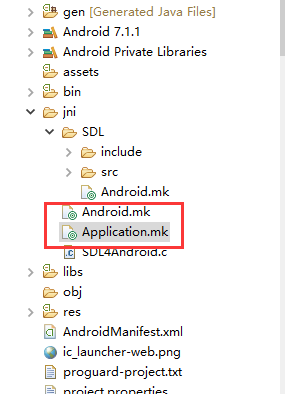
6) Next we add the following code to the SDL4Android.c file:
#include <stdlib.h>
#include <stdio.h>
#include <time.h>
#include "SDL.h"
typedef struct Sprite
{
SDL_Texture* texture;
Uint16 w;
Uint16 h;
} Sprite;
/* Adapted from SDL's testspriteminimal.c */
Sprite LoadSprite(const char* file, SDL_Renderer* renderer)
{
Sprite result;
result.texture = NULL;
result.w = 0;
result.h = 0;
SDL_Surface* temp;
/* Load the sprite image */
temp = SDL_LoadBMP(file);
if (temp == NULL)
{
fprintf(stderr, "Couldn't load %s: %s\n", file, SDL_GetError());
return result;
}
result.w = temp->w;
result.h = temp->h;
/* Create texture from the image */
result.texture = SDL_CreateTextureFromSurface(renderer, temp);
if (!result.texture) {
fprintf(stderr, "Couldn't create texture: %s\n", SDL_GetError());
SDL_FreeSurface(temp);
return result;
}
SDL_FreeSurface(temp);
return result;
}
void draw(SDL_Window* window, SDL_Renderer* renderer, const Sprite sprite)
{
int w, h;
SDL_GetWindowSize(window, &w, &h);
SDL_Rect destRect = {w/2 - sprite.w/2, h/2 - sprite.h/2, sprite.w, sprite.h};
/* Blit the sprite onto the screen */
SDL_RenderCopy(renderer, sprite.texture, NULL, &destRect);
}
int main(int argc, char *argv[])
{
SDL_Window *window;
SDL_Renderer *renderer;
if(SDL_CreateWindowAndRenderer(0, 0, 0, &window, &renderer) < 0)
exit(2);
Sprite sprite = LoadSprite("zx.bmp", renderer);
if(sprite.texture == NULL)
exit(2);
/* Main render loop */
Uint8 done = 0;
SDL_Event event;
while(!done)
{
/* Check for events */
while(SDL_PollEvent(&event))
{
if(event.type == SDL_QUIT || event.type == SDL_KEYDOWN || event.type == SDL_FINGERDOWN)
{
//done = 1;
}
}
/* Draw a gray background */
SDL_SetRenderDrawColor(renderer, 0xA0, 0xA0, 0xA0, 0xFF);
SDL_RenderClear(renderer);
draw(window, renderer, sprite);
/* Update the screen! */
SDL_RenderPresent(renderer);
SDL_Delay(10);
}
exit(0);
}
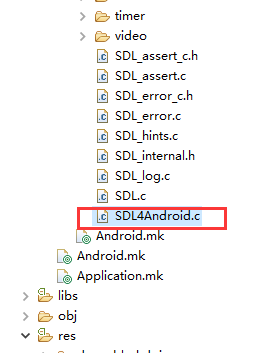
Change YourSourceHere.c from Android.mk in SDL to $(SDL_PATH)/src/SDL4Android.c, and finally the content of the Android.mk file is as follows:
7) At this point, we have basically finished our work. The rest is SDLActivity.java and src in SDL2-2.0.5 android-project.LOCAL_PATH := $(call my-dir) include $(CLEAR_VARS) LOCAL_MODULE := main SDL_PATH := ../SDL LOCAL_C_INCLUDES := $(LOCAL_PATH)/$(SDL_PATH)/include # Add your application source files here... LOCAL_SRC_FILES := $(SDL_PATH)/src/main/android/SDL_android_main.c \ $(SDL_PATH)/src/SDL4Android.c LOCAL_SHARED_LIBRARIES := SDL2 LOCAL_LDLIBS := -lGLESv1_CM -lGLESv2 -llog include $(BUILD_SHARED_LIBRARY) ########################### # # SDL shared library # ########################### include $(CLEAR_VARS) LOCAL_MODULE := SDL2 LOCAL_C_INCLUDES := $(LOCAL_PATH)/include LOCAL_EXPORT_C_INCLUDES := $(LOCAL_C_INCLUDES) LOCAL_SRC_FILES := \ $(subst $(LOCAL_PATH)/,, \ $(wildcard $(LOCAL_PATH)/src/*.c) \ $(wildcard $(LOCAL_PATH)/src/audio/*.c) \ $(wildcard $(LOCAL_PATH)/src/audio/android/*.c) \ $(wildcard $(LOCAL_PATH)/src/audio/dummy/*.c) \ $(LOCAL_PATH)/src/atomic/SDL_atomic.c \ $(LOCAL_PATH)/src/atomic/SDL_spinlock.c.arm \ $(wildcard $(LOCAL_PATH)/src/core/android/*.c) \ $(wildcard $(LOCAL_PATH)/src/cpuinfo/*.c) \ $(wildcard $(LOCAL_PATH)/src/dynapi/*.c) \ $(wildcard $(LOCAL_PATH)/src/events/*.c) \ $(wildcard $(LOCAL_PATH)/src/file/*.c) \ $(wildcard $(LOCAL_PATH)/src/haptic/*.c) \ $(wildcard $(LOCAL_PATH)/src/haptic/dummy/*.c) \ $(wildcard $(LOCAL_PATH)/src/joystick/*.c) \ $(wildcard $(LOCAL_PATH)/src/joystick/android/*.c) \ $(wildcard $(LOCAL_PATH)/src/loadso/dlopen/*.c) \ $(wildcard $(LOCAL_PATH)/src/power/*.c) \ $(wildcard $(LOCAL_PATH)/src/power/android/*.c) \ $(wildcard $(LOCAL_PATH)/src/filesystem/android/*.c) \ $(wildcard $(LOCAL_PATH)/src/render/*.c) \ $(wildcard $(LOCAL_PATH)/src/render/*/*.c) \ $(wildcard $(LOCAL_PATH)/src/stdlib/*.c) \ $(wildcard $(LOCAL_PATH)/src/thread/*.c) \ $(wildcard $(LOCAL_PATH)/src/thread/pthread/*.c) \ $(wildcard $(LOCAL_PATH)/src/timer/*.c) \ $(wildcard $(LOCAL_PATH)/src/timer/unix/*.c) \ $(wildcard $(LOCAL_PATH)/src/video/*.c) \ $(wildcard $(LOCAL_PATH)/src/video/android/*.c) \ $(wildcard $(LOCAL_PATH)/src/test/*.c)) LOCAL_CFLAGS += -DGL_GLEXT_PROTOTYPES LOCAL_LDLIBS := -ldl -lGLESv1_CM -lGLESv2 -llog -landroid include $(BUILD_SHARED_LIBRARY)
Replication of resource files in res replaces resources in the project, deletes unnecessary files, and changes SDLActivity to Start Activity as shown in Figure 1:
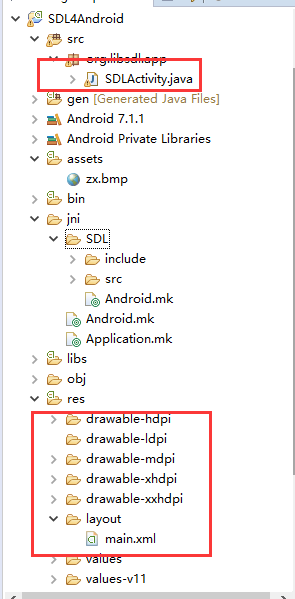
8) Now you can compile the project:
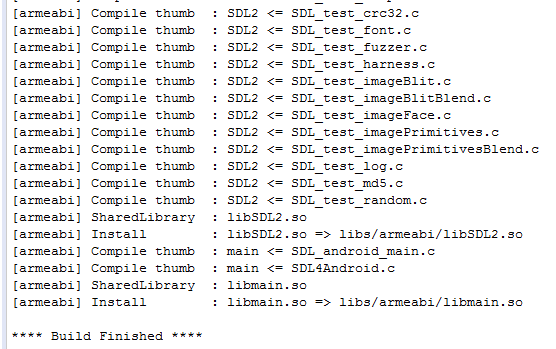
Finally, we generated the. so libraries we needed:
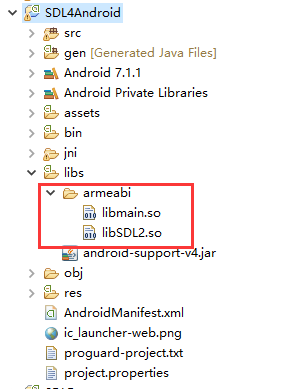
Finally, run our project:
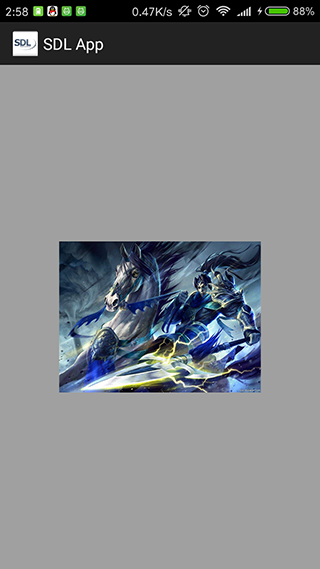
So far, we have successfully compiled the SDL library on Android platform. Then we integrate it with FFmpeg, and we will share it with you later.
Source download address: GitHub
Sleep, good night everyone!!!